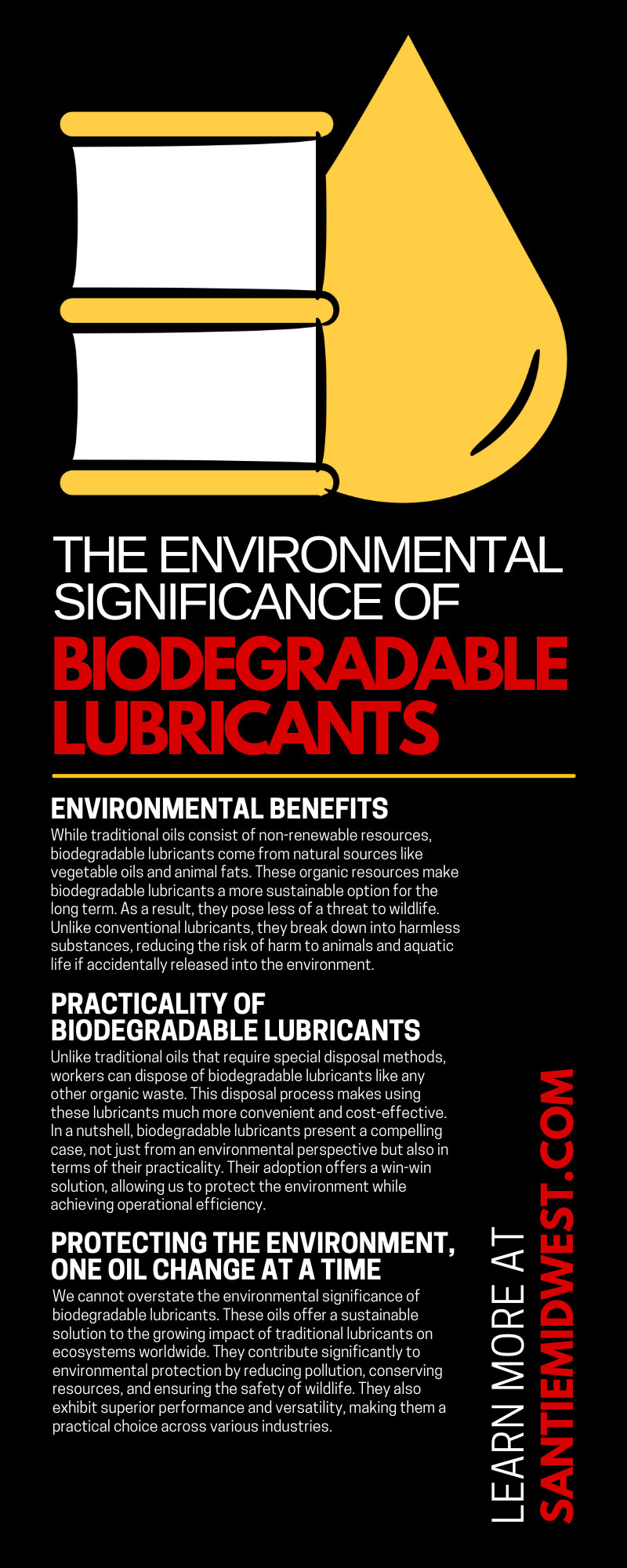The use of lubricants is essential in many industries, from automotive to manufacturing. These oils help reduce friction and wear on moving parts, allowing machines to function smoothly and efficiently. However, the disposal of traditional oils can have severe consequences for the environment if not properly managed. As such, sustainability is not merely an option but becomes an essential component in the sphere of lubricants and oils.
Traditional lubricants are petroleum-based products, which are non-renewable resources and can take years to degrade. This lengthy degradation time often leads to the contamination of soil and water, harming plants, animals, and human beings. While this problem once confounded decision-makers, they’re now adjusting their approach to ensure sustainable operations. By understanding the environmental significance of biodegradable lubricants, managers and decision-makers can create effective change and help usher in a healthy and thriving world for everyone.
The Need for Sustainability
With an increasing focus on sustainability and carbon footprint reduction, industries are turning towards more environmentally friendly options. Biodegradable lubricants offer a sustainable solution as they consist of renewable resources and break down naturally over time. Furthermore, their life cycle, from production to disposal, stands in stark contrast to traditional lubricants, whose environmental footprint often expands well beyond their industrial use. Not only do these lubricants help reduce our impact on the environment, but they also provide numerous benefits over conventional oils.
In a world increasingly defined by our collective response to climate change, the use of biodegradable lubricants demonstrates an adherence to sustainable practices and a commitment to the preservation of our shared environment. As such, sustainability is not merely an option but an essential component in the sphere of lubricants and oils.
Environmental Benefits
Biodegradable lubricants’ ability to break down into natural components over time is one of its primary benefits. Microorganisms in the soil, water, and air aid this degradation process, making it a more sustainable option for the environment. Since biodegradable lubricants break down naturally, they do not release harmful chemicals into the environment—reducing pollution levels and protecting wildlife and multiple ecosystems.
While traditional oils consist of non-renewable resources, biodegradable lubricants come from natural sources like vegetable oils and animal fats. These organic resources make biodegradable lubricants a more sustainable option for the long term. As a result, they pose less of a threat to wildlife. Unlike conventional lubricants, they break down into harmless substances, reducing the risk of harm to animals and aquatic life if accidentally released into the environment.
Practicality of Biodegradable Lubricants
Biodegradable lubricants have been proven to perform just as well, if not better, than conventional oils. They provide excellent protection against friction and wear, ensuring machinery runs smoothly and efficiently. Workers can use these lubricants in a variety of applications, from industrial machinery to personal vehicles. This versatility makes biodegradable lubricants a practical option for various industries and consumers alike.
Unlike traditional oils that require special disposal methods, workers can dispose of biodegradable lubricants like any other organic waste. This disposal process makes using these lubricants much more convenient and cost-effective. In a nutshell, biodegradable lubricants present a compelling case, not just from an environmental perspective but also in terms of their practicality. Their adoption offers a win-win solution, allowing us to protect the environment while achieving operational efficiency.
Types of Biodegradable Lubricants
The range of biodegradable lubricants in the market is broad and diverse, each type offering unique benefits and features. Let’s explore some of the most used types.
- Vegetable Oil-based - These lubricants consist of vegetable oils such as canola, soybean, or sunflower. They offer excellent biodegradability and high lubricity, making them suitable for many applications.
- Polyalkylene Glycol (PAG) - PAG lubricants are synthetic and have high stability, making them ideal for use in extreme temperatures. They also provide excellent lubricity and biodegradability.
- Polyalphaolefins (PAOs) - Polymerizing an alpha-olefin creates these PAOs and offers performance benefits such as enhanced wear protection, excellent thermal stability, and lower volatility. While PAOs are not as readily biodegradable as vegetable oils or synthetic esters, they are less toxic than traditional petroleum-based lubricants.
- Esters – These lubricants come from organic acids and offer exceptional performance and biodegradability. Workers often use them in applications such as hydraulic systems and two-stroke engine oils.
By understanding the different types of biodegradable lubricants available, industries can make informed decisions on which lubricant suits their applications best, aligns with their sustainability goals, and fulfills their operational needs.
The Role of Regulations
Many countries have implemented regulations to control the use and disposal of lubricants, with a focus on reducing their environmental impact. Stricter environmental regulations are forcing industries to rethink their lubrication strategies and consider more sustainable alternatives. Governments worldwide are implementing stringent rules on the disposal of used lubricants, levying hefty fines on improper disposal and spills that harm the environment. Furthermore, specific sectors, such as shipping and aviation, are subject to additional regulations that mandate the use of environmentally acceptable lubricants (EALs) in particular applications.
These regulations are not just about compliance. They underline the importance of corporate responsibility in safeguarding our environment. Using biodegradable lubricants can help companies comply with these regulations while promoting sustainable practices within their operations. The transition to biodegradable lubricants is not merely a matter of regulatory adherence but an integral part of sustainable business practices.
Protecting the Environment, One Oil Change at a Time
We cannot overstate the environmental significance of biodegradable lubricants. These oils offer a sustainable solution to the growing impact of traditional lubricants on ecosystems worldwide. They contribute significantly to environmental protection by reducing pollution, conserving resources, and ensuring the safety of wildlife. They also exhibit superior performance and versatility, making them a practical choice across various industries.
With numerous benefits and practicality in various applications, it’s clear that biodegradable lubricants are a crucial step towards creating a more sustainable future. Industries are not only prolonging the lifespan of their machinery but also ensuring the longevity of our planet by choosing biodegradable lubricants. So, let’s make the switch to these eco-friendly alternatives and do our part in safeguarding the environment for generations to come. It’s time to make a difference, one oil change at a time.


